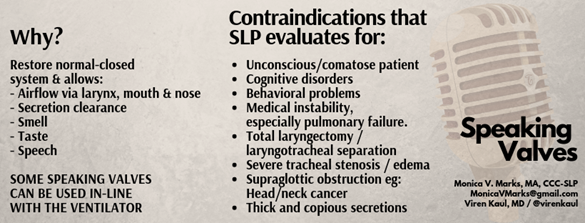Power of the Speaking Valve
By: Monica V. Marks, MA, CCC-SLP, and Viren Kaul, MD
June 12, 2019
What is a speaking valve?
A speaking valve is a one-way air flow valve for tracheostomized patients. Many health-care providers may be familiar with the Passy Muir speaking valve (PMV), but there are actually several other brands of speaking valves that exist. One-way valves may vary in their size, design, valve resistance, etc. Some popular one-way valves are: Tracoe® 650-T phone assist, Shiley® Phonate, Montgomery®, Shakani®, among others.
What does a speaking valve do?
A speaking valve is a removable one-way valve that can be placed on a deflated or cuffless tracheostomy tube. It allows for inhalation through the valve and closes on exhalation to allow for airflow through the larynx, mouth, and nose. Use of a speaking valve can restore sense of smell and taste. The speaking valve maintains subglottic pressures for speaking and swallowing, essentially restoring the patient’s normal-closed system. There are also speaking valves that be used in-line with the ventilator.

What are the benefits of a speaking valve?
As the name describes, the speaking valve allows for the patient to voice and communicate verbally. The valve also restores positive airway pressure, facilitating the patient’s ability to generate a protective cough, improving airway protection when swallowing. Research studies have found that patients with an occluded (closed system) have improved airway protection and aspirate less than those with an open system (Suiter 2003, Gross 2003, Elpern 2000). Use of speaking valves facilitate the decannulation process and are often used prior to capping trials.
What are the contraindications for speaking valve use?
There are several contraindications for speaking valve use that the speech language pathologist and/or tracheostomy team will assess and monitor for, including:
*(Adapted from Gross 2006).
- Patients with severe behavior problems
- Unconscious/comatose patients
- Patients with cognitive disorders
- Severe medical instability, especially pulmonary failure
- Severe tracheal stenosis or edema
- Any airway obstruction above the tube that precludes expiration through the glottis
- Thick and copious secretions that persist after valve placement
- Foam-filled tracheotomy tube cuff (Bivona)
- Total laryngectomy or laryngotracheal separation
- Insufficient passage for air around the tube, either with the cuff down or with a cuffless tube
- Inability to maintain adequate ventilation with cuff deflation in a ventilator-dependent patient
- If valve is already placed, the valve should be removed if skin color changes
- The valve should be removed if the patient shows increase restlessness, stridor, grunting, head bobbing, or other signs of anxiousness
References:
- Gross RD, Mahlmann J, Grayhack, JP. Physiologic effects of open and closed tracheostomy tubes on the pharyngeal swallow. Annals of Otology, Rhinology & Laryngology. 2003;112(2):143-152.
- Gross RD, Eibling DE. Passy-Muir valve/decannulation. In: Carrau R, Murry T, eds. Comprehensive Management of Swallowing Disorders. San Diego, CA: Plural Publishing; 2006: 255-262.
- Elpern EH, Borkgren M, Bacon M, Gerstung C, Skrzynski M. Effect of the Passy- Muir tracheosotomy speaking valve on pulmonary aspiration in adults. Heart and Lung: The Journal of Acute and Critical Care. 2000;29:4287-293.
- Suiter DM, McCullough GH, Powell PW. Effects of cuff deflation and one-way tracheostomy speaking valve placement on swallow physiology. Dysphgia. 2003;18(4): 284-292.
Authors:
Monica V. Marks, MA, CCC-SLP | MonicaVMarks@gmail.com
Viren Kaul, MD | Twitter: @virenkaul